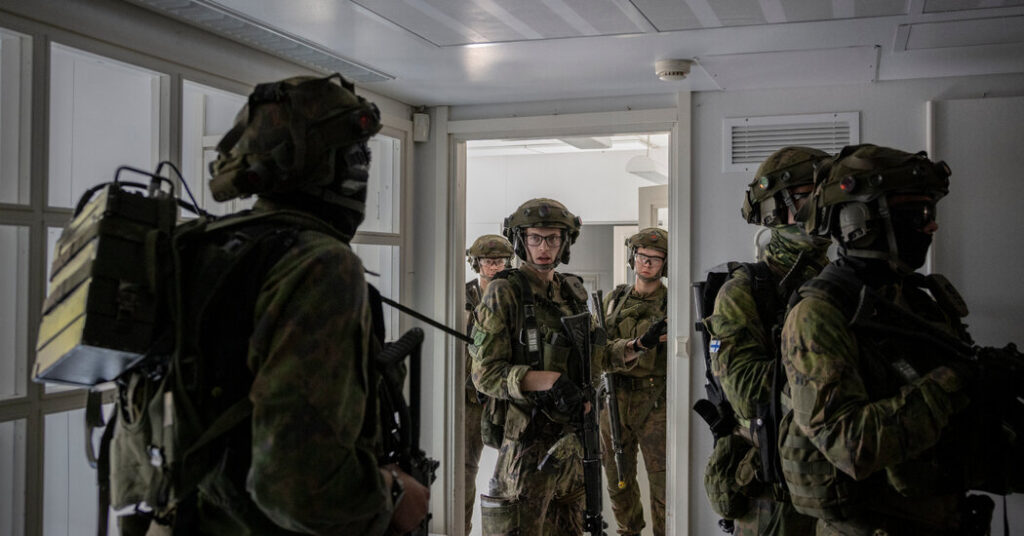The drones that have veered near airports in Germany, Poland, Belgium and Estonia and frequent incidents of sabotage are chilling reminders of how Russia’s relentless war in Ukraine could easily spill into Europe.
The threat has put intense pressure on countries across the continent and in Britain to quickly expand the ranks of full-time soldiers and reservists that shrank during the post-Cold War peace. Yet the question of how to recruit hundreds of thousands of service members is prompting fierce and soul-searching debates.
After bitter disagreements that touched on economics, politics and military strategy, the German government decided this month to forgo mandatory military service in favor of a volunteer force — although it left the door open to a draft if the number of recruits falls short.
Croatia took a different path and, a few weeks earlier, restored conscription, which had been abolished 18 years ago.
In Poland, plans are underway for every man to go through military training as the country’s president, Donald Tusk, aims to more than double its army, to 500,000 from 200,000.
And Denmark, which wants to grow its forces from 70,000 to 200,000 by 2030, extended its draft to include women and prolong the service period to 11 months from four. “The defense needs all the fighting power we can mobilize,” said Michael W. Hyldgaard, Denmark’s defense chief.
Other countries vow to do a better job of attracting volunteers to fulfill national targets and commitments to NATO.
France announced plans to roll out an optional military service program next year. And Britain hired a private recruitment company to create a streamlined process in 2027 to rebuild its depleted ranks.
Yet even so, the outlook for meeting targets is dim. “Retention rates remain low in many countries, reserve schemes are uneven and recruitment has dwindled in aging societies with low unemployment,” the International Institute for Strategic Studies, a European think tank, concluded in a recent report.
The calculations of how to build an effective fighting force are complex. Particularly at a time when, on average, less than one-third of European Union citizens said they were willing to fight for their country in a war, according to a Gallup poll in 2024, more than two years after Russia invaded Ukraine.
The poll found that in the United States — where conscription ended in 1973 during the Vietnam War when antiwar protesters were turning “I Want You” posters into “I Want Out” signs — 42 percent were willing to pick up arms.
On one side of the argument, serving in the military is a civic duty and a binding force — an experience that transcends geographical, racial, ethnic and class differences. It is also the fairest way of distributing the burden of defense, supporters say.
On the other: Conscription has no place in free societies and comes at an enormous economic cost, compelling citizens to work in jobs that divert them from making the best use of their skills and talents.
During his 1968 campaign, President Richard M. Nixon, influenced by the work of the Nobel Prize winning free market economist Milton Friedman — not to mention voter sentiment — referred to forced enlistment as a “huge hidden tax.”
In Europe, 12 countries, including Turkey, a member of the Atlantic alliance, have some form of conscription. Recent polls found that most people in Germany, France and Poland support reintroducing a form of mandatory military service.
Proximity to Russia is clearly a factor. Finland, which shares an 832-mile border with Russia, maintained conscription even after the fall of the Soviet Union. So did nearby Norway and Denmark. Sweden reinstituted the practice for men and women in 2017. Estonia, Latvia and Lithuania, former Soviet states, all have variations of a draft.
Most of the successful conscription programs still largely depend on volunteers, said Sophia Besch, a senior fellow in the Europe program at the Carnegie Endowment for International Peace.
Norway and Sweden, for instance, require all men and women to register, but there is a rigorous selection process based on a long questionnaire, physical tests and a desire to serve.
In Lithuania, Latvia and Denmark, there are lotteries if the number of volunteers falls short.
Governments sweeten the pot with incentives. Norway offers conscripts a bonus after they complete their service. In Latvia, volunteers can later enroll free in higher education programs. And under the new law in Croatia, conscripts will get preferential treatment when applying for jobs at public and state-run institutions.
“We will make voluntary service more attractive,” Jens Spahn, the parliamentary leader of the Christian Democratic Union party in Germany, said after this month’s vote.
The German government wants to increase the number of active-duty members to 260,000 from 180,000, and reservists to 200,000 from 50,000 over the next decade to create the “strongest conventional army in the E.U.”
The question of how to best build up an armed force is taking place at a time of uneasy transition. Growth is slowing, and European economies are under enormous stress as the global trading system is being upended. Technological advancements are transforming warfighting and causing strategists to rethink assumptions about how to most effectively deploy troops.
Also, President Trump has made clear he is dialing down American commitments and demanding European forces be responsible for their own security as well as Ukraine’s. Last month, the administration reduced the number of U.S. troops in Romania, NATO’s eastern flank.
“We are safe now,” Mark Rutte, the secretary general of NATO, told European Parliament members in January, soon after taking office. “We might not be safe in five years.”
Generally, military leaders tend to prefer volunteer forces, arguing they have higher levels of skill, professionalism and morale with less turnover.
But instilling a willingness to serve in countries without a recent history of military service takes time and prolonged debate, said Ms. Besch of the Carnegie Endowment, who cowrote a report on strategies for increasing Europe’s armed forces.
A volunteer army requires that the military offer pay and benefits to compete with the private sector. That can provide economic opportunities for poor youths with less education who often make up a disproportionate share of people who enlist. But it also shifts the dangerous burden of defense to the most disadvantaged.
Training, equipping, feeding, housing and managing an army is expensive, as are the pension and health care costs that continue long after soldiers finish service.
In France, the High Commission for Strategy and Planning estimated that training 70,000 volunteers for six months would cost 1.7 billion euros annually. Requiring six months of military service for roughly 300,000 young men would cost €7.2 billion. Including women would double the numbers.
In any case, fulfilling troop targets remains a struggle. Britain’s strategic defense review this year found a “work force crisis” within the military. In Germany, 20 percent of officer and noncommissioned officer posts were unfilled last year, according to the parliamentary commissioner for the armed forces.
“Most European armies struggle to both meet their recruitment targets and retain trained personnel, as well as generate a sufficient reserve,” the International Institute for Strategic Studies found.
But any plan to solve the problem, it noted, depends on political will and popular support.
Patricia Cohen writes about global economics for The Times and is based in London.
The post A Draft or Volunteers? Russian Threat Prompts Urgent Debate in Europe. appeared first on New York Times.




